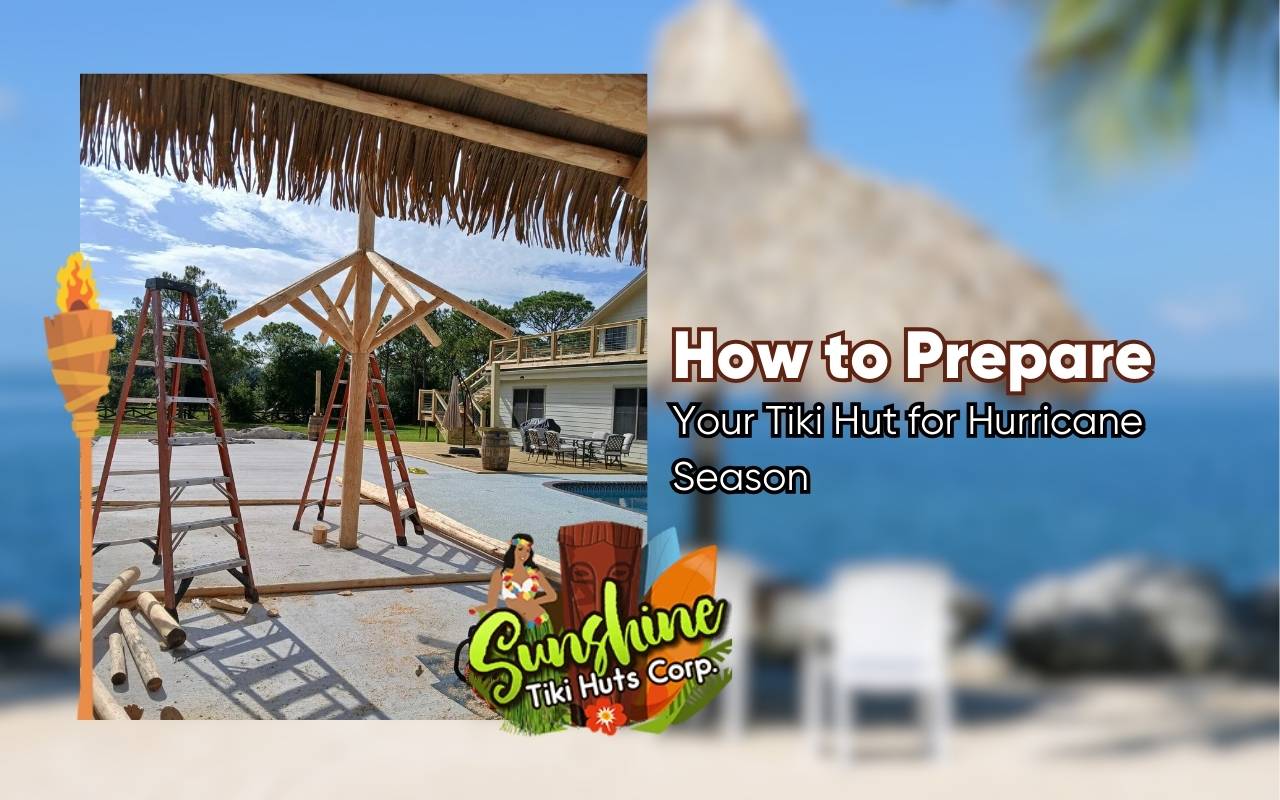
Hurricane season can be unpredictable, bringing strong winds and heavy rain. Knowing how to prepare your tiki hut for hurricane season is essential. Without the right precautions, storms can damage thatched roofs, weaken wooden posts, and create costly repairs. Reinforcement, inspection, waterproofing, and emergency planning not only safeguard your tiki hut but also help protect your loved ones during extreme weather.
Florida’s tropical climate makes tiki huts a popular outdoor feature. However, these structures are vulnerable to hurricanes and tropical storms. Preparing in advance protects your investment and keeps your space safe. In this guide, you’ll find essential tips for preparing tiki huts for hurricanes to ensure they withstand strong winds, heavy rain, and flying debris.
Understanding the Risks Hurricanes Pose to Tiki Huts

Hurricanes bring strong winds, heavy rain, and debris that can significantly damage tiki huts. Coastal humidity and salt air can also speed up wood decay, while gaps in roof joints allow water intrusion.
- Wind Damage – High-speed winds can lift thatch, loosen wooden beams, or even collapse weak structures.
- Heavy Rainfall – Prolonged rain can cause wood rot, leading to instability.
- Debris Impact – Objects carried by the wind may hit the hut, damaging the roof or posts.
- Flooding Risks – Water accumulation weakens foundations and makes the structure unsafe.
- Tree Hazards – Nearby branches or leaning trees can fall and crush the roof.
Maintenance and Reinforcement Before Hurricanes
Routine maintenance strengthens your tiki hut before hurricane season. A well-maintained and reinforced structure has a much higher chance of surviving a storm.
- Inspect the Roof – Look for loose or missing thatch, cracks, or leaks. Seal joints with marine-grade sealant to prevent water intrusion.
- Check for Weaknesses – Ensure wooden beams, lashings, and posts are sturdy and not decayed.
- Apply Waterproofing – Use UV-resistant sealants and wood preservatives to fight rot and insects.
- Install Hurricane Straps – Use galvanized or stainless-steel straps every few feet along rafters.
- Anchor Posts – Expansion anchors set in concrete create a continuous load path against uplift.
- Trim Surrounding Trees – Remove overhanging limbs within 10 feet of the hut and clear shrubs brushing the thatch.
- Secure Outdoor Furniture – Store lightweight items indoors and strap down heavy furniture.
These steps create a sturdier, hurricane-resistant structure that can endure high winds and heavy rain.
Emergency Preparation and Safety Protocols
Beyond structural reinforcement, preparation also involves having the right tools, supplies, and safety measures in place.
- Emergency Kit – Stock hurricane straps, bolts, tarps, tools, marine-grade sealants, plus essentials like food, water, flashlights, and a first-aid kit.
- Storm Checklist – Keep an inspection and preparation checklist in a waterproof folder.
- Evacuation Plan – Establish safe zones, assign duties, and set up group communication protocols for emergencies.
Having both a reinforced tiki hut and a family safety plan provides peace of mind during hurricane season.

Post-Hurricane Tiki Hut Maintenance and Recovery
After the storm, immediate inspection and repairs are crucial to avoid further deterioration.
- Inspect for Damage – Check roof thatch, support posts, straps, and anchors for displacement or cracks.
- Clean and Dry – Remove debris, dry out moisture, and prevent mold growth.
- Repair Weak Areas – Replace damaged thatch, reinforce posts, and reapply sealants.
- Upgrade Materials – Consider hurricane-rated thatch and durable lumber for long-term resilience.
Quick action ensures your tiki hut is restored and stronger for future storms.
Florida Hurricane Regulations for Tiki Huts
Understanding local building codes and hurricane regulations is important:
- Permit Requirements – Some areas require permits for larger tiki huts.
- Building Codes – Certain materials and fasteners must meet hurricane-resistant standards.
- Electrical Installations – Huts with lighting may require additional approvals.
FAQs
How can I protect my tiki hut from high winds?
Reinforce posts, secure thatch with hurricane straps, and remove nearby projectiles.
How often should I inspect my tiki hut before hurricane season?
At least once in early spring, leaving time for repairs before storms.
What materials work best for reinforcement?
Galvanized or stainless-steel hurricane straps and concrete expansion anchors provide superior durability.
Can I waterproof my tiki hut myself?
Yes, but for larger repairs, professional help is recommended.
What should be in my tiki hut emergency kit?
Straps, bolts, tarps, tools, sealants, food, water, first aid, and a preparation checklist.
Do I need permits for my tiki hut in Florida?
Some locations require permits—always check with local authorities.
Prepare Your Tiki Hut for Hurricane Season Now
Hurricane preparation is crucial to protect your tiki hut and your family. By reinforcing the foundation, waterproofing the roof, trimming nearby trees, and following safety protocols, you minimize risks and extend the life of your tiki hut.
If you need expert help, we offer professional tiki hut reinforcement and repair services.
- Licensed and insured professionals.
- Over 16 years of experience.
- Call us at (786) 847-2597 for expert tiki hut services.
Act now—preparation today prevents costly repairs tomorrow. Contact us and ensure your tiki hut is hurricane-ready!




